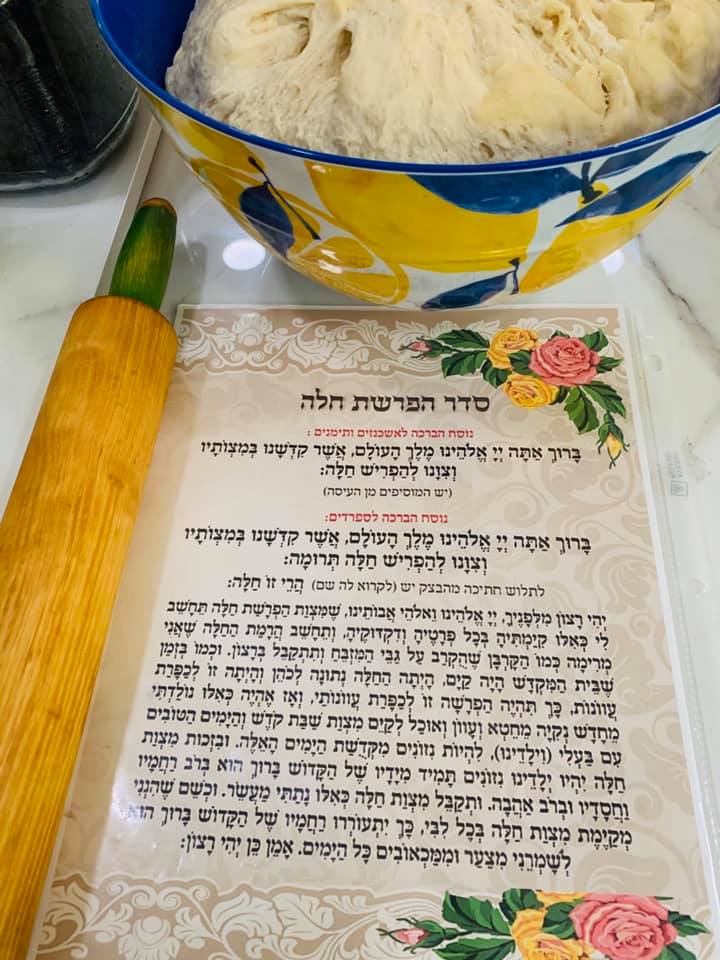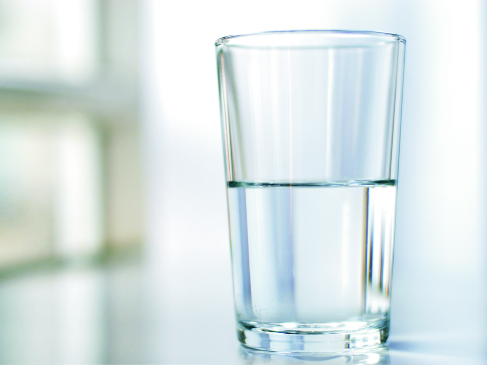Hafrashat Challah

From generation to generation
I remember vividly seeing my mom doing the mitzvah of challah every week as she baked delicious cakes and cookies for Shabbat. When I was little I asked her “why do you throw away a small portion of the dough?!” she replied, “this is how we do it, your Grandma did it, and my Grandma did it, and one day, with God’s will, when you’ll have your own family, you will do it as well”. For many years, in all honesty, I totally forgot about it and never did hafrashat challah. In December of 2019, I needed healing, I needed comfort, something was missing and I couldn’t figure it out, and then out of the blue, like magic it came to me, the seed that my mom planted so many years ago began to take roots, the memory of my childhood started to bloom like the most beautiful flower, and I decided to give it a try. It was the very first time I did the Challah mitzvah, early in the morning, without my family knowing about it. Friday evening, during our weekly Shabbat dinner, they tasted it after The Hamotie Lechem Min Ha’aretz prayer, The blessing over the Challah, and they (drum roll) LOVED it, they said it was THE BEST Challot I have ever made, apparently two Challot for Shabbat filled with prayers taste much better. It was an elevating, spiritual and magical moment for me. I do it on a weekly basis ever since.

Challah is positive mitzvah #133
A little bit of a background. In the Torah we have 613 commandments total. 248 positive commandments plus 345 negative commandments. Challah is Positive Mitvah #133 that the children of Israel were commanded to follow after crossing The Jordan River upon entering The Promised Land. It is also one of the three special mitzvot of women and girls (1. Challah, 2. Laws of family purity, 3. Lighting of Shabbat and holiday candles). For centuries, while baking and preparing bread dough for their families, Jewish women separated challah from the dough.
וְהָיָ֕ה בַּֽאֲכָלְכֶ֖ם מִלֶּ֣חֶם הָאָ֑רֶץ תָּרִ֥ימוּ תְרוּמָ֖ה לַֽיהֹוָֽה:
רֵאשִׁית֙ עֲרִסֹ֣תֵכֶ֔ם חַלָּ֖ה תָּרִ֣ימוּ תְרוּמָ֑ה כִּתְרוּמַ֣ת גֹּ֔רֶן כֵּ֖ן תָּרִ֥ימוּ אֹתָֽהּ:
מֵֽרֵאשִׁית֙ עֲרִסֹ֣תֵיכֶ֔ם תִּתְּנ֥וּ לַֽיהֹוָ֖ה תְּרוּמָ֑ה לְדֹרֹ֖תֵיכֶֽם:

The Torah states: “You shall offer up a loaf (challah) from the first of your dough as a gift” (Numbers 15:20). This loaf is among the twenty-four gifts that G‑d awarded to the kohanim, the priests.
When should I do hafrashat challah?
When you bake bread and cookies and use large amounts of flour you are required to do Hafrashat Challah, separate Challah, and make a brachah. The dough can be made from wheat, barley, spelt, oats, or rye. There are several opinions as to the minimum size of dough which requires the Bracha, however common practice is to recite a Bracha if five pounds of flour or more is used in the dough, which is about 11.5 cups of flour.
What does Challah represents?
Challah represents the idea of taking something physical and elevating it to the spiritual. Not only are we providing physical nourishment to those who eat our Challah, but they are also being nourished spiritually with the thoughts and blessings that we conjure up while we are making our Challah.
Challah basic ingredients
There are six basic ingredients in a Challah recipe; flour, water, yeast, sugar, oil, and salt. There is a special secret ingredient that is unique to each and every one of us, and that is your neshamah, your soul. When we are making the Challah we are putting our personal spiritual energy and blessings into the dough. Whoever eats the Challah also ingests these Divine blessings.

FLOUR– As we sift the flour we are sifting through our thoughts, speech and actions. We are removing the impurity and desires of the yetzer hara. We pray that only positive influences and blessings are left in our life.

WATER– water symbolizes life and Torah. Just as we cannot live without water we also cannot live without Torah. Water provides life-force and nourishment to all things. As we add the water, we pray that abundant kindness will flow down into our lives, just as water flows. A home filled with Torah for all generations to come.

YEAST– Yeast is what enables our dough to rise. It represents growth and expansion. When we add the yeast, we pray that are loved ones grow and expand in their emotional, physical, and spiritual well being. We wish for our homes to expand that we may be able to invite guests. We desire for our children to expand their minds with Torah knowledge. We ask God to help us rise to who we are meant to be. The Hebrew word for yeast is, shmarim -“shemirah,” which means protection. As we add the yeast, we pray for protection for ourselves, our families, and all of the Jewish people. We ask that God will protect us from the yetzer hara and from ayin hara.
(evil eye)

OIL– Oil represents anointment as it was used to anoint the Jewish kings during ancient times. When adding oil to the dough slowly name each one of your loved ones and pray for their specific needs. Pray that just as oil makes things soft, our words and actions should be softened, and less stubborn in our ways.

SUGAR– Sugar represents sweetness. We pray that all our speech should be pleasant and sweet and that the Torah should be as sweet as honey.

SALT– Salt represents discipline or criticism. It is important to discipline but in smaller measures. When adding the salt we pray to for God’s help in disciplining our children in the appropriate way. Salt also represents purification. We pray that anything that is toxic in our lives should be removed. Salt is the ingredient used to extract impurities. We pray that we should merit to keep all the halachot of kashrut properly and set correct boundaries for ourselves and family.
Et Ratzon

The time when a woman kneads the dough is a special time (Et Ratzon). We pray for peace in our homes and in Am Israel. We ask God to help create unity in the world, just as all the ingredients come together to form one dough. We pray for unity in the home and a closeness between us and the Creator.
Lighting Candles

Some woman light two candles and dedicate them to two tzadikim as they pray for the safety and peace of their home and for every Jew in Am Israel.
Giving versus taking
In our material world, some people have the perception that when they give something away, there is less of it. It is an illusion. The Torah teaches us that the more we give away, the more we will have. This is the idea of tzedakah (charity), giving ma’aser (a tithe). By giving tzedakah, we will merit the blessing of more parnasah (sustenance). Challah is the same way. Somehow, even after we separate a piece of the dough we still have enough to make many baked goods. When we become used to giving, it turns us into unselfish people who learn what it means to be givers and not takers. Imagine a world of givers. Imagine what a wonderful world it will be. Practice the art of giving, one Challah at a time, and in return you will get so much more. Amen Ken Yehi Ratzon
My Vegan Challah Recipe
I was asked to share my Challah recipe. We all know there are many great recipes out there… however, since we’re vegan, all my baking recipes has to exclude eggs.

My Vegan Challah Recipe
9 cups of flour 2 ounce dry yeast
1/2 cup oil.
1/2 cup sugar
2 teaspoons of sugar.
3 cups water
2 teaspoons of salt.
*Separately dissolve yeast plus 2 teaspoons of sugar and Half a cup of water (5 minutes)
*Mix the rest of the ingredients plus the dissolved yeast.
Leave the dough to rise and double in size.
*It will make 2-3 challah.
You may freeze some of the unbaked dough,
Or you can make a chocolate challah as well 🙂
*I personally glaze it with Silan (Date syrup) and sesame seeds.
*On line you’ll find many braiding techniques…. and remember it doesn’t have to be perfect the first, second or third time! Mine are never perfect…. yet:) Enjoy and let me know how it came out!
Check out YedidYah Psalm 93 for Friday “Adonai Malach” music by Rabbi Yakira copyright 2020
Hafrashat challah blog was inspired by chabbad.org, and ohelsarah.org